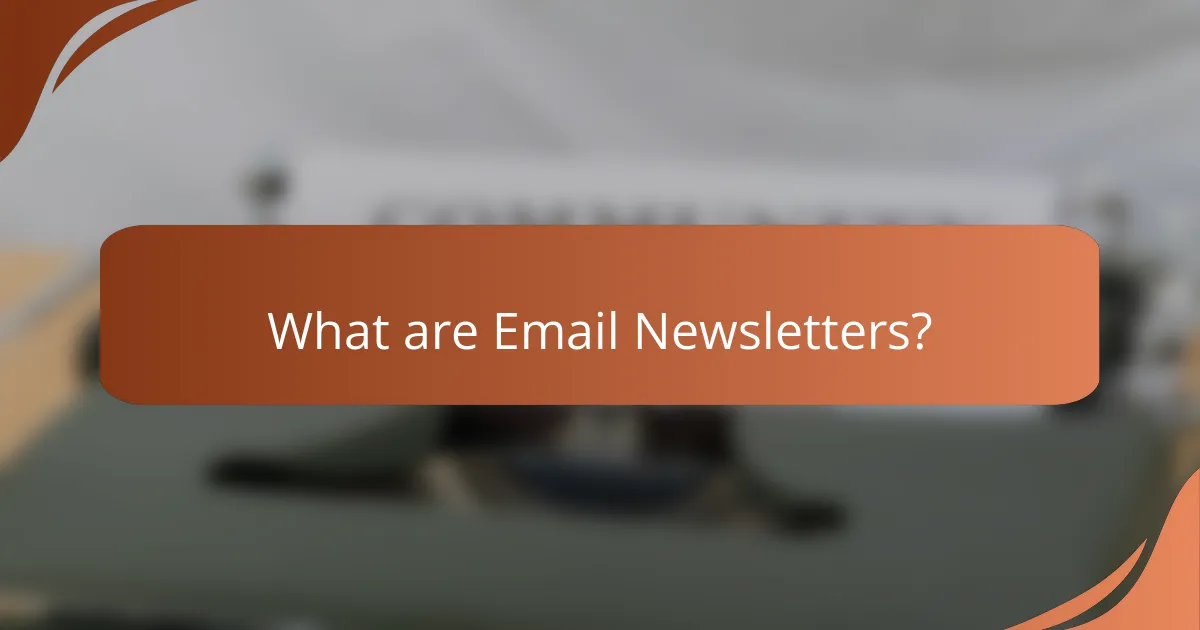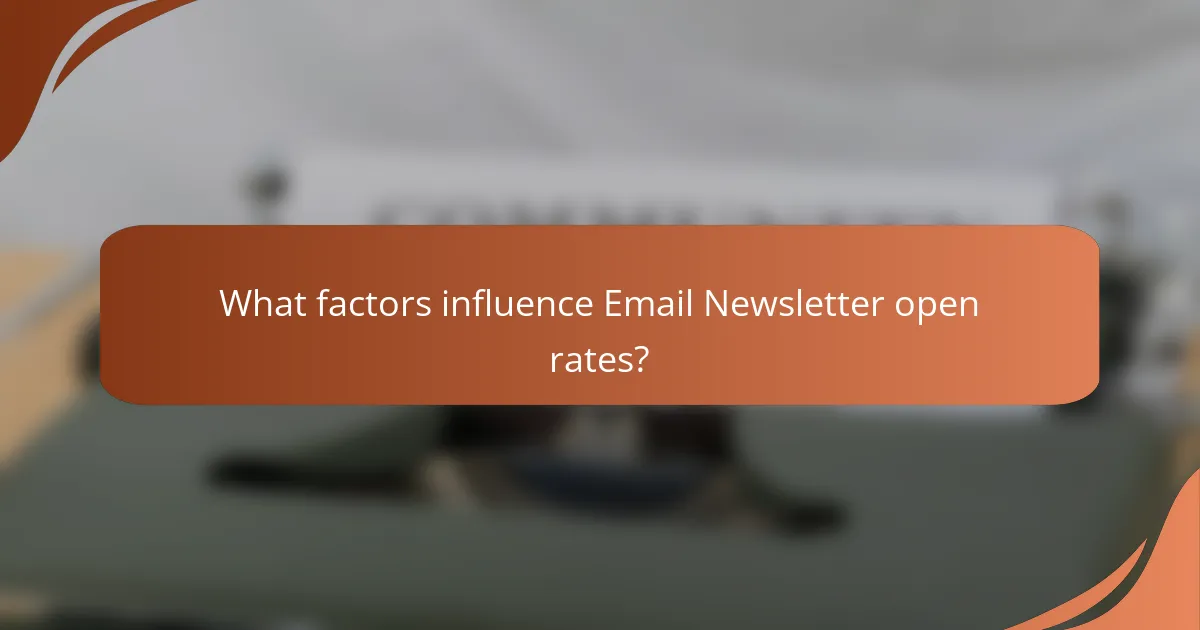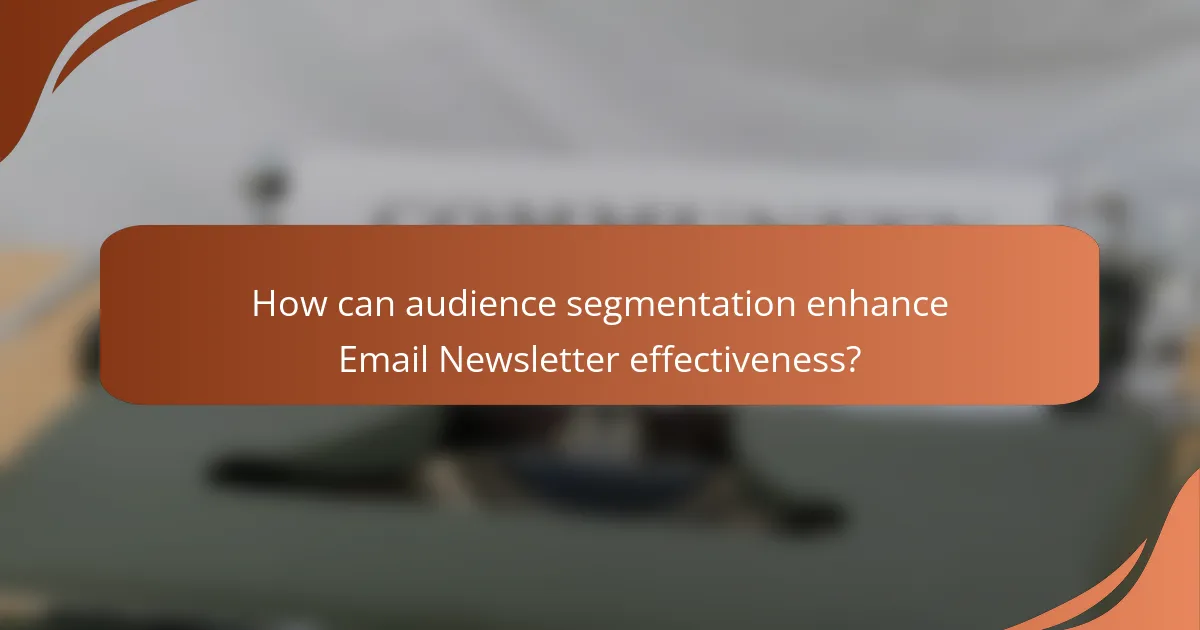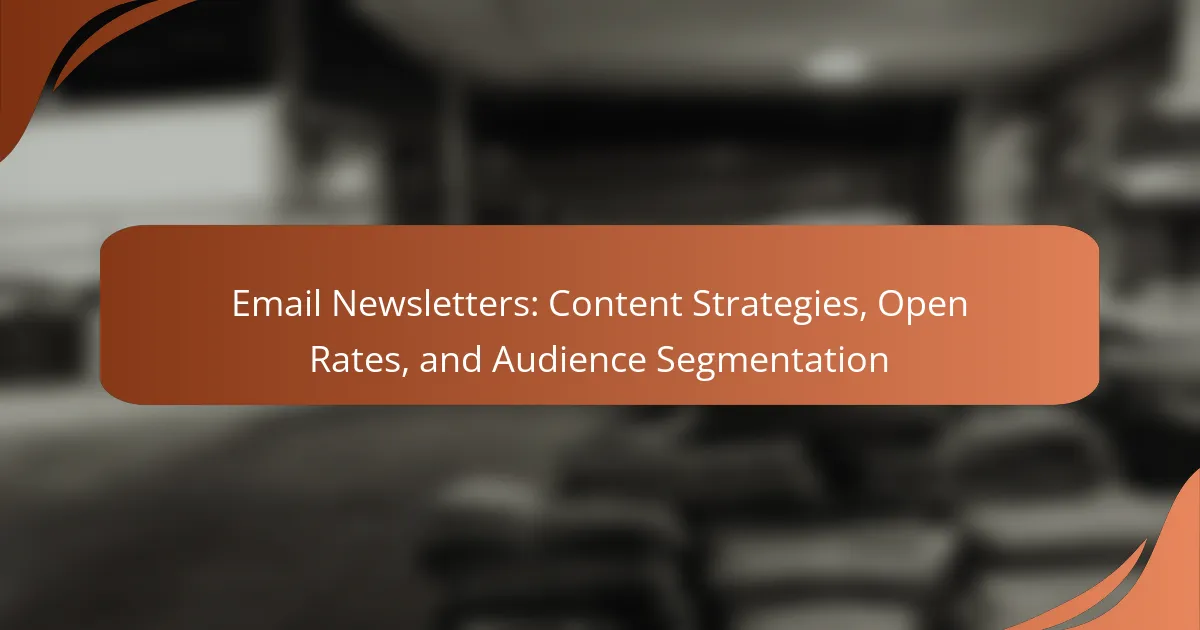Email newsletters are digital communications sent to subscribers, providing updates, promotions, and curated content relevant to specific audiences. This article explores the effectiveness of email newsletters, highlighting their average open rates of 20-30% and their ability to drive website traffic and enhance customer loyalty. Key factors influencing open rates include compelling subject lines, personalization, optimal send times, and mobile optimization. Additionally, audience segmentation is discussed as a crucial strategy for improving engagement and revenue, with segmented campaigns achieving significantly higher performance metrics. The article emphasizes the importance of tailoring content to audience preferences for improved overall campaign effectiveness.

What are Email Newsletters?
Email newsletters are digital communications sent via email to subscribers. They typically contain updates, news, promotions, or curated content relevant to the audience. Email newsletters serve to engage and inform recipients about a brand, organization, or topic. According to the Direct Marketing Association, email newsletters have an average open rate of 20-30%. This statistic demonstrates their effectiveness in reaching audiences. Email newsletters can also drive traffic to websites and increase customer loyalty.
How do Email Newsletters function in digital marketing?
Email newsletters function in digital marketing by delivering targeted content directly to subscribers’ inboxes. They serve as a communication tool that builds relationships with audiences. Marketers use email newsletters to share updates, promotions, and valuable information. This approach helps to engage customers and drive traffic to websites. According to the 2021 Email Marketing Benchmark Report, email newsletters have an average open rate of 21.33%. This statistic highlights their effectiveness in reaching audiences. Additionally, segmenting email lists can improve engagement rates by tailoring content to specific interests. Overall, email newsletters are a key strategy in digital marketing for nurturing leads and retaining customers.
What are the key elements of an effective Email Newsletter?
An effective email newsletter includes several key elements. First, a compelling subject line is crucial. It should grab attention and encourage opens. Next, personalized content enhances engagement. Tailoring messages to the recipient’s preferences can increase relevance.
Additionally, a clear call to action guides readers on what to do next. This could be visiting a website or signing up for an event. Consistent branding strengthens recognition and trust. Using a recognizable logo and color scheme reinforces brand identity.
Moreover, mobile optimization is essential. Many users access emails on mobile devices, so responsive design is necessary. Lastly, valuable content keeps readers interested. Providing insights, tips, or exclusive offers encourages loyalty and repeat opens.
How does the design impact the effectiveness of Email Newsletters?
The design of email newsletters significantly impacts their effectiveness. A well-structured layout enhances readability and engagement. Clear visual hierarchy guides the reader’s attention to key information. Consistent branding fosters trust and recognition among recipients. Effective use of images and colors can evoke emotions and drive actions. Research shows that newsletters with appealing designs can increase click-through rates by up to 42%. A mobile-responsive design ensures accessibility across devices, further improving user experience. Additionally, personalized design elements can enhance relevance, leading to higher engagement rates.
What are the primary benefits of using Email Newsletters?
Email newsletters provide direct communication with an audience. They enhance customer engagement and foster loyalty. Newsletters allow for personalized content delivery, increasing relevance to subscribers. They can drive traffic to websites and promote products effectively. According to a 2021 HubSpot study, email newsletters have an average ROI of $42 for every $1 spent. This makes them a cost-effective marketing strategy. Additionally, they help in building a brand’s authority and credibility. Regular updates keep subscribers informed about new offerings and company news. Email newsletters also facilitate data collection through analytics, informing future strategies.
How do Email Newsletters enhance customer engagement?
Email newsletters enhance customer engagement by providing personalized content directly to subscribers. They create a direct line of communication between brands and customers. This format allows brands to share updates, promotions, and valuable information. Research shows that personalized emails can lead to a 26% increase in revenue. Regular newsletters keep the audience informed and connected. They encourage interaction through calls to action, driving traffic to websites. Engaged customers are more likely to make repeat purchases. According to a study by Campaign Monitor, email marketing has an ROI of 4400%.
What role do Email Newsletters play in brand awareness?
Email newsletters play a crucial role in enhancing brand awareness. They provide a direct channel for brands to communicate with their audience. Regular updates keep the brand top-of-mind for subscribers. Engaging content fosters a connection between the brand and its audience. This connection can lead to increased customer loyalty. According to a study by the Direct Marketing Association, email marketing has an average ROI of $42 for every dollar spent. Consistent branding in newsletters reinforces brand identity. This helps in differentiating the brand from competitors.

What factors influence Email Newsletter open rates?
Email newsletter open rates are influenced by several key factors. Subject lines play a critical role; they must be compelling and relevant. Personalization increases engagement, making recipients feel valued. Send time also affects open rates; optimal timing can vary by audience. Frequency of emails matters; too many can lead to fatigue. Mobile optimization is essential, as many users check emails on mobile devices. List segmentation improves targeting, ensuring content is relevant to specific groups. A/B testing can identify what resonates best with the audience. According to Mailchimp, emails with personalized subject lines have a 26% higher open rate.
How does subject line optimization affect open rates?
Subject line optimization directly increases open rates. Effective subject lines grab attention and entice recipients to open emails. Research indicates that 47% of email recipients decide whether to open an email based solely on the subject line. Personalized subject lines can boost open rates by 26%. A/B testing different subject lines can reveal what resonates best with the audience. Additionally, clarity and brevity in subject lines improve engagement. Subject lines with urgency or exclusivity also lead to higher open rates. Overall, well-optimized subject lines are crucial for successful email marketing campaigns.
What are best practices for crafting compelling subject lines?
Compelling subject lines should be concise and clear. Aim for 6-10 words to maintain reader interest. Use actionable language to encourage engagement. Personalization can increase open rates by 26%, according to a study by Experian. Create urgency with time-sensitive phrases. Avoid spammy words to prevent filtering. Testing different formats can reveal what resonates best with your audience. Analyze performance metrics to refine future subject lines.
How do personalization and segmentation impact open rates?
Personalization and segmentation significantly enhance open rates in email marketing. Personalization involves tailoring content to individual recipients based on their preferences and behaviors. Segmentation categorizes audiences into distinct groups based on shared characteristics. Research shows that personalized emails can achieve a 29% higher open rate compared to non-personalized ones. Additionally, segmented campaigns can result in 14.31% higher open rates than non-segmented ones. Effective personalization and segmentation strategies lead to more relevant content, increasing the likelihood of engagement.
What timing strategies can improve open rates?
Sending emails at optimal times can significantly improve open rates. Research shows that emails sent on Tuesdays and Thursdays tend to have higher open rates. Additionally, sending emails in the morning between 9 AM and 11 AM is often effective. Emails sent during lunchtime, around 12 PM, also capture attention. Timing should consider the target audience’s time zone for maximum impact. A/B testing different send times can help identify what works best for specific audiences. According to Mailchimp, open rates can increase by 20% when emails are sent at the right time. Analyzing past campaign performance can provide insights into optimal timing.
How does audience behavior influence the best times to send newsletters?
Audience behavior significantly influences the best times to send newsletters. Understanding when your audience is most active can lead to higher open rates. For instance, research shows that emails sent during weekdays, particularly Tuesday through Thursday, tend to perform better. This is because most people check their emails during work hours. Additionally, audience demographics, such as age and occupation, can dictate optimal sending times. Younger audiences may engage more during evenings, while professionals might prefer early mornings. Analyzing past engagement data helps identify specific patterns in audience behavior. This data-driven approach ensures newsletters reach recipients when they are most likely to read them.
What tools can help analyze optimal sending times?
Email marketing tools that can help analyze optimal sending times include Mailchimp, HubSpot, and Sendinblue. Mailchimp offers insights based on user engagement and historical data. HubSpot provides analytics that suggest the best times to send based on recipient behavior. Sendinblue uses machine learning to optimize send times for maximum engagement. According to a study by Mailchimp, emails sent on Tuesdays and Thursdays tend to have higher open rates. These tools leverage data analytics to enhance email campaign effectiveness.

How can audience segmentation enhance Email Newsletter effectiveness?
Audience segmentation enhances email newsletter effectiveness by allowing targeted messaging to specific groups. This approach increases engagement rates as content becomes more relevant to recipients. Research shows that segmented campaigns can achieve up to 760% higher revenue than non-segmented ones. By analyzing demographics, interests, and behaviors, marketers can tailor their messages accordingly. Personalized content resonates better, leading to higher open and click-through rates. Additionally, segmentation helps in reducing unsubscribe rates as users receive content that aligns with their preferences. Overall, effective segmentation fosters stronger connections with the audience and improves overall campaign performance.
What are the different types of audience segmentation for Email Newsletters?
The different types of audience segmentation for email newsletters include demographic, geographic, psychographic, and behavioral segmentation. Demographic segmentation divides audiences based on age, gender, income, and education level. Geographic segmentation targets audiences based on location, such as country, city, or climate. Psychographic segmentation focuses on lifestyle, values, interests, and personality traits of the audience. Behavioral segmentation analyzes user behavior, including purchase history, engagement level, and email interaction. Each segmentation type helps tailor content to specific audience needs, enhancing engagement and conversion rates.
How can demographic segmentation improve targeting?
Demographic segmentation can significantly improve targeting by allowing marketers to tailor their messages to specific audience groups. This approach enables the identification of distinct characteristics such as age, gender, income, and education level. By understanding these attributes, marketers can create content that resonates more deeply with each segment. For instance, targeting younger audiences may involve using more casual language and contemporary references. In contrast, targeting older demographics might focus on trust and reliability in messaging.
Research shows that personalized marketing can lead to a 20% increase in sales (source: McKinsey & Company). By leveraging demographic data, businesses can enhance engagement rates and improve overall effectiveness in their email campaigns. This strategic approach ensures that the right message reaches the right people at the right time.
What is behavioral segmentation and how does it work?
Behavioral segmentation is the process of dividing a market based on consumer behaviors. This approach analyzes patterns in how customers interact with products or services. It focuses on factors such as purchase history, usage frequency, and brand loyalty. Marketers use this data to tailor messages and offers to specific segments. For example, a company may target frequent buyers with exclusive discounts. This increases engagement and conversion rates. Research shows that personalized marketing can boost sales by up to 20%. By understanding customer behavior, businesses can enhance their email newsletter strategies.
What tools and techniques can be used for effective segmentation?
Effective segmentation can be achieved using various tools and techniques. Customer Relationship Management (CRM) systems help organize and analyze customer data. Email marketing platforms like Mailchimp and Constant Contact offer segmentation features based on user behavior and demographics. Data analytics tools can provide insights into customer preferences and engagement patterns. Surveys and feedback forms can gather information directly from subscribers to refine segments. A/B testing allows marketers to test different content with specific segments to improve engagement. Social media analytics can also inform segmentation by identifying audience interests. These tools and techniques enhance targeting and personalization in email newsletters.
How can data analytics enhance audience segmentation strategies?
Data analytics can enhance audience segmentation strategies by providing insights into user behavior and preferences. It enables marketers to analyze data from various sources such as website interactions, purchase history, and social media engagement. By identifying patterns in this data, marketers can create more targeted and personalized segments. For instance, a study by McKinsey & Company found that companies using data-driven segmentation strategies can increase marketing ROI by 15-20%. This approach allows businesses to tailor their email newsletters to specific audience needs, improving open and click-through rates. Ultimately, data analytics transforms audience segmentation from a broad approach to a precise, data-informed strategy.
What role does A/B testing play in refining audience segments?
A/B testing plays a crucial role in refining audience segments by allowing marketers to compare different versions of content. This method helps identify which variations resonate better with specific audience groups. By analyzing performance metrics, marketers can determine preferences and behaviors of different segments. A/B testing provides data-driven insights that guide content strategy. These insights lead to more personalized and effective email newsletters. According to a study by Mailchimp, segmented campaigns can result in a 14.31% higher open rate. This demonstrates the effectiveness of using A/B testing for audience segmentation.
What are the best practices for creating engaging Email Newsletter content?
To create engaging email newsletter content, focus on personalization and relevance. Tailor your content to the interests and preferences of your audience. Use attention-grabbing subject lines to increase open rates. Research shows that personalized subject lines can improve open rates by 26%.
Incorporate visuals to enhance the appeal of your newsletter. Studies indicate that emails with images receive 42% more clicks than those without. Keep your content concise and scannable. Use bullet points and subheadings to make it easy to read.
Include clear calls to action to guide readers on what to do next. A/B testing can help identify which elements resonate best with your audience. Consistency in sending frequency builds anticipation and trust. Regularly analyze performance metrics to refine your strategy.
How can storytelling be used to connect with the audience?
Storytelling can be used to connect with the audience by creating relatable narratives that evoke emotions. These narratives help to humanize brands and make them more approachable. Emotional connections can enhance audience engagement and retention. Research indicates that stories can increase information retention by up to 22 times compared to facts alone. This is due to the brain’s natural affinity for narratives, which makes content more memorable. Furthermore, storytelling fosters a sense of community among readers, allowing them to see themselves reflected in the content. This connection can lead to higher open rates and better audience segmentation in email newsletters.
What types of content should be prioritized in Email Newsletters?
Email newsletters should prioritize personalized content, valuable insights, and engaging visuals. Personalized content increases engagement by addressing subscribers’ interests directly. Valuable insights, such as industry trends or expert tips, provide readers with useful information. Engaging visuals, including images and infographics, enhance the overall appeal of the newsletter. According to a study by HubSpot, personalized emails can lead to a 29% higher open rate. Additionally, incorporating user-generated content fosters community and encourages interaction. Prioritizing these content types can significantly improve reader retention and engagement.
Email newsletters are digital communications sent to subscribers, containing updates, news, and promotions relevant to the audience. This article covers the role of email newsletters in digital marketing, highlighting their effectiveness in enhancing customer engagement and brand awareness through personalized content and strategic design elements. Key factors influencing open rates, such as subject line optimization, timing strategies, and audience segmentation, are also discussed. Additionally, best practices for crafting engaging content and utilizing data analytics for refining audience segments are examined, providing a comprehensive overview of effective email newsletter strategies.
